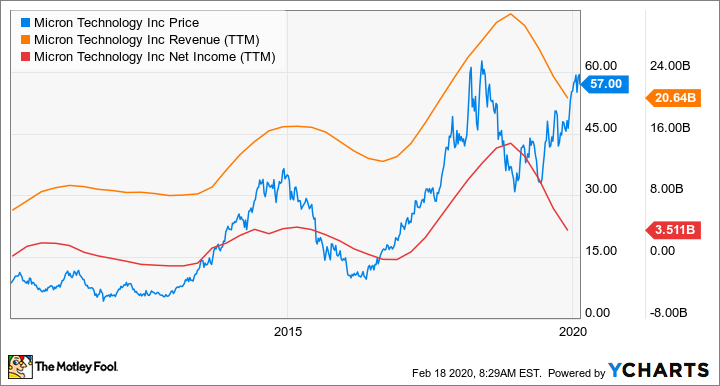Where Will Micron Technology Be in 10 Years? – Motley Fool
Shareholders of Micron Technology (NASDAQ:MU) are used to volatility. After rising almost 500% from 2016 to mid-2018, shares dropped around 50% for the rest of the year as semiconductor prices fell from oversupply. Then shares rose more than 60% in 2019, and now sit even with highs reached in 2018. That’s quite a ride.
Now the pundits are divided on where Micron is headed in 2020. But it’s much easier to predict the company’s general direction over the next 10 years. A recovering semiconductor cycle should provide Micron with cash to buy back stock, and plenty of capital to develop the new kinds of memory products needed in the future.

Image source: Micron Technology.
The infamous semiconductor cycle
It’s often pointed out that Micron operates in the cyclical semiconductor industry, where the delicate balance between supply and demand is easily upset. And Micron’s 10-year results perfectly illustrate this cyclical reality.
MU data by YCharts. TTM = trailing 12 months.
The chart shows that, while cyclical, the semiconductor industry keeps cycling higher. Micron’s revenue and net income spiked to all-time highs in 2018 as the semiconductor cycle peaked, driven by higher cellphone shipments, increased vehicle semiconductor components, and data center growth. Cycles are just part of the semiconductor industry. Over the next decade, there should be a few more highs and lows, but overall demand should continue to trend higher.
Right now, Micron believes the upcoming second quarter will be its lowest point of the present cycle, and revenue and net income will still rival that of the previous peak in 2014. Furthermore, it may even be able to maintain positive free cash flow throughout Q2, unlike previous cycle lows.
Free cash flow is particularly important for Micron investors. The company targets returning 50% of free cash flow to them via share repurchases. As this cycle has trended down, free cash flow decreased. But in 2018, during the last boom cycle, Micron generated $9.2 billion in free cash flow. That led the company to start a $10 billion share buyback program in 2019. So far, it has bought back around $2.8 billion in stock.
Free cash flow comes after other expenses have been paid, and Micron has one very important expense that it can’t afford to skimp on: research and development (R&D). Semiconductor technology is constantly being updated and improved, requiring companies to innovate to keep pace. “Semiconductor” is a broad term referring to a variety of products. In Micron’s case, it manufactures semiconductor memory products, with the bulk of revenue generated from DRAM and NAND memory. All told, Micron spent $2.4 billion on R&D in fiscal 2019, or about 10% of revenue, to keep pace in the ever-changing memory segment.
That gives Micron one of the largest R&D budgets in the industry. At first glance, it pales versus the $13.4 billion Intel (NASDAQ:INTC) spent. But it’s not an apples-to-apples comparison. Only a portion of Intel’s R&D budget goes toward memory products; the company has other products like processors and software. We don’t know the exact percentage that goes toward memory products, but it’s safe to say that Micron’s and Intel’s memory R&D budgets are a lot closer in size than they appear.

Source: Getty Images.
Over the next 10 years
I believe one of the world’s mega-trends is the rise of data creation and storage, and memory demand looks to increase for a long time. In its first-quarter earnings call, management said it expects long-term demand to grow at a compound annual growth rate in the mid-teens for DRAM, and 30% for NAND.
But at some point in the next decade, semiconductor makers will likely reach the limits of DRAM and NAND technology. As a simplistic example, to improve NAND memory, you increase the amount of layers it has. Right now, Micron is working on 128-layer NAND memory. In 2016, Micron peer SK Hynix believed the limit of NAND to be 256 layers. Others believe the theoretical limit is around 500 layers. Whatever the limit, it’s possible it will be reached in the next 10 years, requiring the development of new kinds of memory. That’s another reminder why Micron’s R&D budget is so important.
At this point, it’s pure speculation what kind of memory we’ll be using in 2030. Some like the idea of resistive random-access memory (ReRam) replacing dynamic random-access memory (DRAM). In very simple terms, ReRam works by changing the voltage between two electrodes on a memory chip to create or remove conductive bridges between them. The technology promises to be fast yet inexpensive while using relatively little power. At the 2019 VLSI symposium on semiconductors, Intel discussed that it’s already in the very early stages of working on this kind of memory. There’s also potential for magnetoresistive random-access memory (MRAM) to replace NAND in time.
But there’s another kind of memory product out there called 3D XPoint, which some see as a subset of ReRam. Offering both speed and stability, 3D XPoint has potential particularly in data centers, and Micron is one of only two companies that has the technology. Micron and Intel developed it together, but Micron exercised the option to buy the project outright. The deal closed in 2019.
Intel is free to pursue 3D XPoint technology, and it plans to. But Micron has an accelerated path to commercializing the product, since it has the equipment and the staff from the previous joint venture. Micron’s management admits it’ll take time to profit from 3D XPoint, but it’s worth watching for investors. If Micron successfully runs ahead of the competition in 3D XPoint, that will make me more optimistic of its chances to leverage its R&D budget to create other new kinds of memory over the next decade and beyond.







